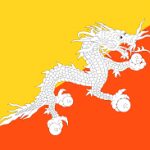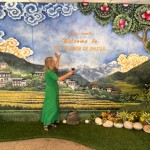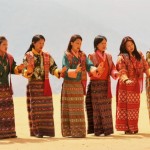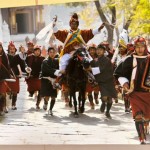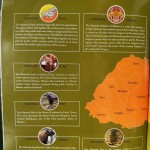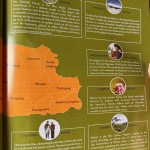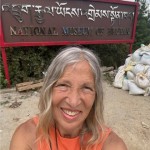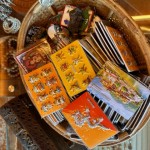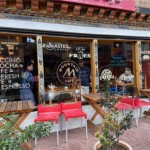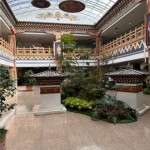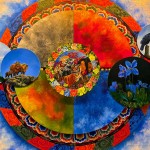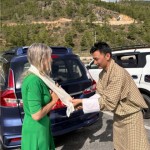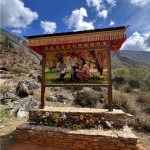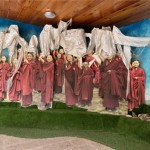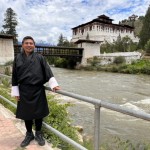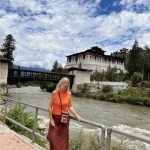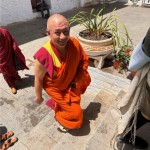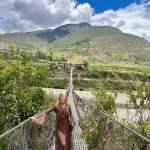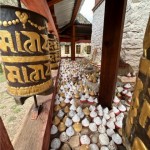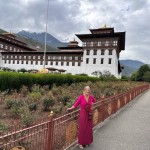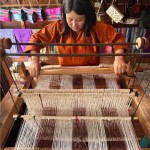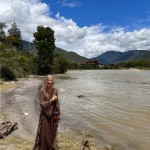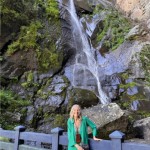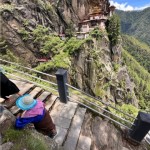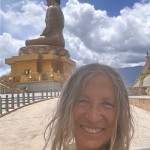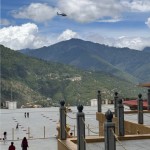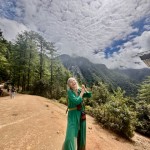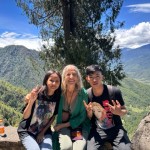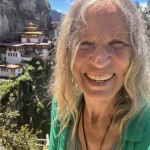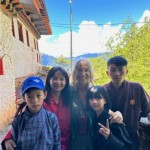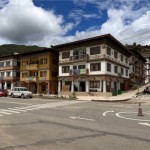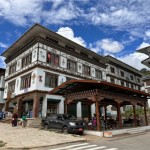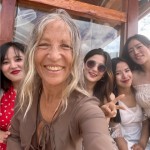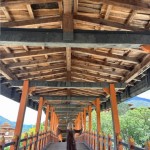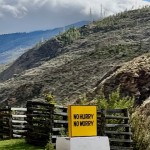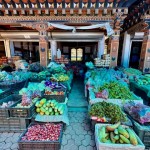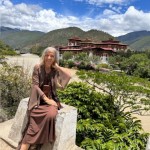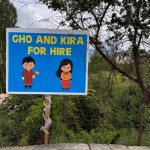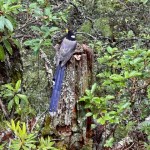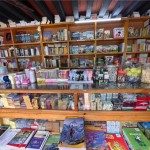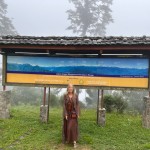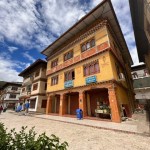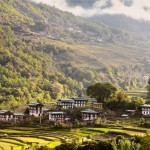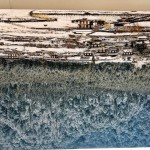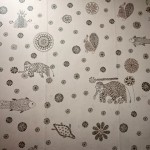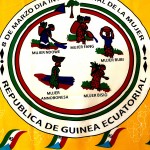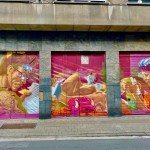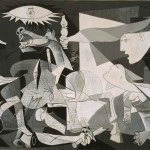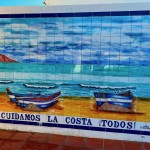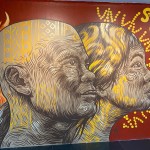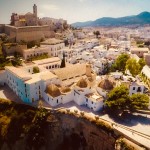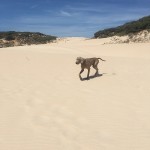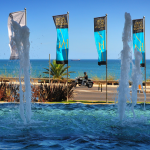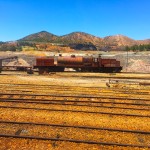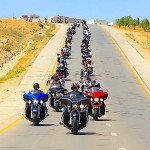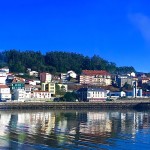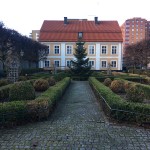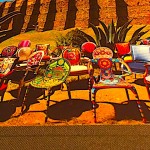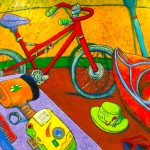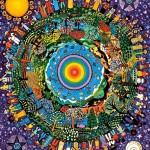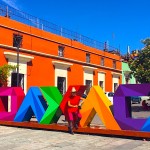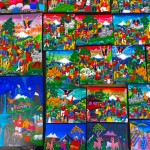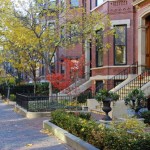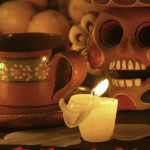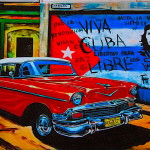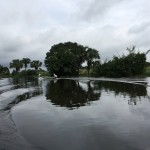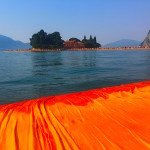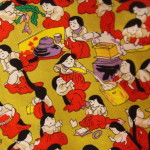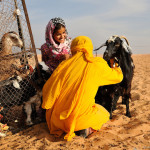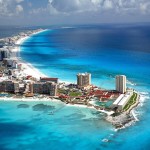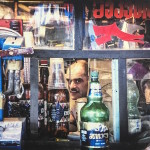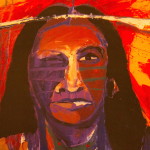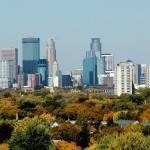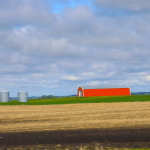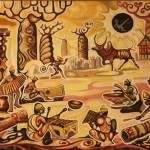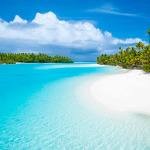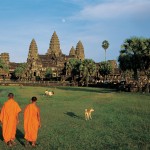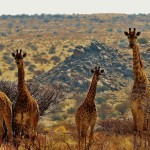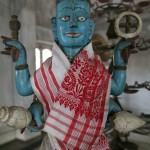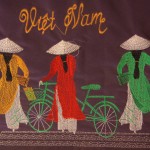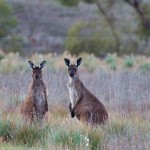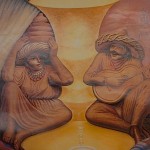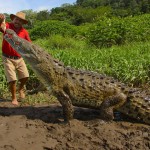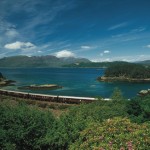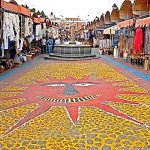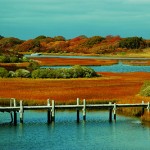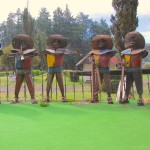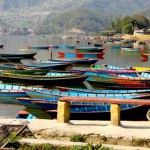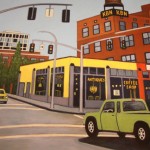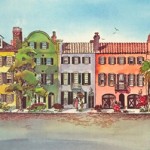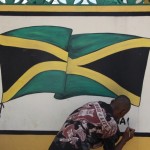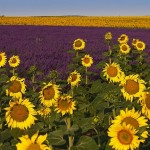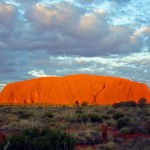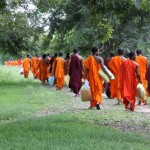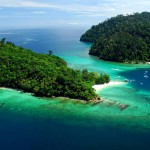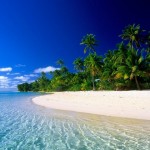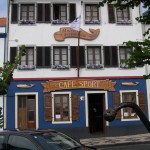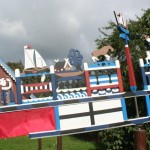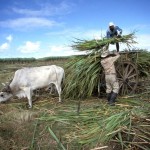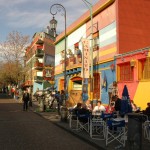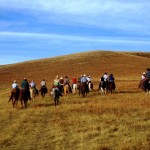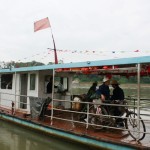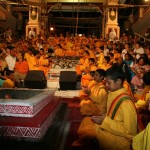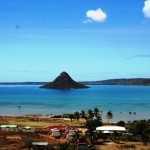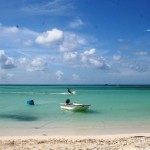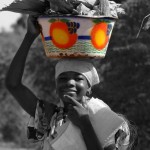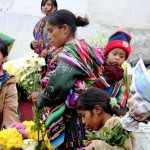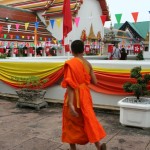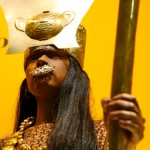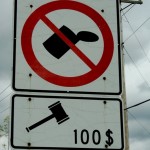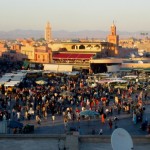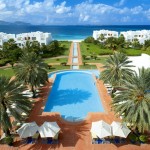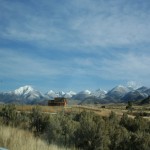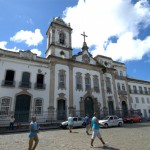How beautiful is Bhutan, safe, kind, peaceful and also clean. Perhaps the reason is the payment of a daily (and per person) “tourist” tax of 200 dollars imposed on visitors, (the amount includes some services, which can be defined directly in the Agency, see our info below).
However who gets there, will visit a small Kingdom on a human scale, a sort of mountain paradise certainly far from mass tourism and will enter between mountains, valleys, monks’ monasteries at the foot of the Himalayas between 1500 and 3500 meters above sea level, with rivers that descend towards the Ganges.
- bandiera-Bhutan
- aeroporto-di-Paro-appena-arrivati
The entire nation has a territory slightly larger than Switzerland and is inhabited by about eight hundred thousand inhabitants. Entering it is equivalent to taking a step into a bygone era because for the Bhutanese the quality of the air, the health of citizens, the education and the wealth of social relationships really matter much more than money. The road signs that continually praise respect for others also remind us of this. We have not seen a plastic bottle thrown on the street. We have not seen a cigarette butt around (in 2004 Bhutan was the first country in the world to ban the sale and use of tobacco within national borders, even if modernity allows it today). We have not found a beggar give alms.
- una-danza-delle-donne-del-Bhutan-copyright-tourism-Bhutan
- Uno dei festival (foto copyright-tourism-of-Bhutan)
Traffic is not congested, the air is clear and breathable, also thanks to the many evergreen pines that frame rapeseed plantations, barleys, rice fields terraced. Winters are harsh and summers are humid and quite rainy due to the monsoons from the Bay of Bengal, but between April and May the great Bhutanese Festivals bring the monks out of the monasteries (because Bhutan is a stronghold of Buddhism) filling not only the towns, and creating unspeakable moments of local life, among colorful costumes, evocative dances and music of cymbals. And even if Bhutan is remote, luxury experiences remaining within tradition, culture, art, decorum and a healthy lifestyle, are possible.
- Rivista DrukAir, compagnia nazionale Bhutan
- Rivista DrukAir, compagnia nazionale Bhutan, per capire a cosa tiene la nazione
We leave from Paro at 2,200 meters, home of the international airport and we sit down at the Mountain Cafè especially to take heart from the fact that we are landed in one of the most dangerous airports in the world (it seems that only 8 pilots are authorized to land on it; we saw the big plane dribble right /left descending quickly and entering the valley, almost brushing the high mountains with the wings).
- al-national-museum-del-Bhutan-in-Paro
- i-magneti-con-anche-la-bandiera-del-Bhutan
Every house we will see from now on presents an unmistakable architecture that cannot be found in other places of the world, either of the Indian sub-continent. And almost every person we meet on the street, even on weekdays, wear a dress that recalls tradition, the gho for the men’s costume (to wear without underpants) and the kira for the women.
- Paro-al-Mountain-cafe
- aeroporto-di-Paro-in-Bhutan
The small town of Paro is crossed by the river and on its banks there is the famous Rinpung Dzong built in 1644 (with its wooden bridge) and immortalized in 1993 in some scenes of Bernardo Bertolucci’s film “Little Buddha”. And for those who want to better understand the local customs and culture, “Lunana” is the title of one of the last films shot in Bhutan that best describes them.
- I colori del Bhutan
- il-benvenuto-in-Bhutan
A few kilometers from Paro, you arrive at the place to climb to the Tiger Nest (the Taktsang), one of the most famous monasteries also because to reach it you have to walk, reach the top at 3500 meters, with a vertical drop of 400 meters to do in about 2/3 hours , it depends on your personal pace (you can also get on horseback to arrive right in front of the ravine and see in front the monastery still on the other side of the mountain).
- la-famiglia-Reale
- aeroporto-di-Paro
Everywhere, not only in Paro, the photos of King Jigme Khesar Namgyel Wangchuck dominate with his beautiful wife Jetsun and their two boys, but the family will soon increase because these days Jetsun has a big belly. The King’s residence cannot be visited, but the great Royal Palace can be visited, beautiful at sunset because its hundred windows turn red.
Thimphu, on the other hand, is the capital of the Kingdom and to get there from Paro there are two hours of travel by car. Arriving at Chuzom, note the three Chörten (the Tibetan name for the Buddhist stupas) in Nepalese, Tibetan and Bhutanese style, all three aligned at the confluence of the Paro Chhu and Wang Chhu rivers.
Shortly after, the National Memorial Chörten frequented at all hours by the faithful who walk around turning their prayer wheels incessantly and it is here that we had the pleasure of meeting Jigme Do-mgag Tenzin, one of principal head of the monks of the Bhutan, considering from Buddhists a reincarnation of one of the important treasure founder.
- Renchien, la nostra guida (vedi info in fondo)
- il-famoso-chunzom-di-Paro-con-il-suo-ponte-in-legno
But, for the best landscape, is better go up to the so-called Great Buddha Dordenma, a 50-metre-high statue completely made in China.
All the population appears somatically beautiful, proud and smiling; and in the local markets you will find ancient crafts, and you will see with your own eyes the women who make cheap original products, even water-repellent ones such as those made with yak hair.
- Jigme Do-mgag Tenzin
- il-ponte-sospeso-piu-lungo-del-bhutan
From Thimphu, therefore, in just under three hours you can reach the Punakha Valley through the Dochula Pass at an altitude of 3,140 meters. It’s the most photographed pass in Bhutan and when there are no clouds (rarely) you can see the whole Himalayan range, exactly as shown by the giant photo you will find on site.
To eat or sleep you can also choose the local hospitality by tasting the food of the families (remembering that the buthanese food is strongly influenced by the Indian, where vegetables and spices prevail over everything).
- dettaglio-di-una-stupa
- Thimphu
We personally really liked the town of Punakha, ancient capital of Bhutan and its placid Valley and you can get there by passing the classic road signs that remind us of the important things in life at every turn. Important not only on the road. Among them, “litter is an offense”. In a planet that badly needs cleaning, it was a joy to see that in Bhutan deeds are made, not just words!
ITALIANO: Che bello il Bhutan, sicuro, gentile, pacifico e anche pulito. Che questo centri, o meno, con l’enorme selezione dovuta al pagamento di una tassa “di soggiorno” giornaliera (e a persona) di 200 dollari imposta ai visitatori, è arduo da definire (l’importo include alcuni servizi, definibili direttamente in Agenzia, vedi le nostre info sotto). Però, chi ci arriva visiterà un piccolo Regno a misura di essere umano, incastonato tra valli e montagne della catena Himalayana, una sorta di paradiso montano certamente lontano dal turismo di massa.
Montagne, monasteri e monaci ai piedi dell’Himalaya tra i 1500 e i 3500 metri di altitudine, tra valli e fiumi che scendono verso il Gange.
- mercato-di-manufatti-artigianali-a-Thimphu
- nella-valle-di-Punakha-alla-confluenza-dei-due-fiumi
L’intera nazione ha un territorio poco più grande della Svizzera ed è abitato da circa ottocento mila abitanti. Entrarci equivale a fare un passo in una epoca passata perché per i bhutanesi la qualità dell’aria, la salute dei cittadini, I’istruzione e la ricchezza dei rapporti sociali contano davvero molto di più del denaro. Lo ricordano anche i cartelli stradali che continuamente inneggiano al rispetto degli altri. Non abbiamo visto una bottiglia di plastica gettata per strada. Non abbiamo visto un mozzicone di sigaretta in giro (nel 2004 il Bhutan è stato il primo paese al mondo a vietare la vendita e l’uso di tabacco entro i confini nazionali), anche se oggi la modernità lo permette), non abbiamo trovato un mendicante fare l’elemosina. Il traffico non è congestionato, l’aria è limpida e respirabile, complice anche i tantissimi pini sempre verdi, le piantagioni di colza, risaie, e orzo terrazzati. L’inverno è rigido e l’estate è umida e piuttosto piovosa a causa dei monsoni del Golfo del Bengala. Tra aprile e maggio i grandi Festival bhutanesi portano i monaci a uscire dai monasteri (perché il Bhutan è una roccaforte del buddismo), riempiendo non solo le cittadine e creando un momento di vita locale inenarrabile, tra costumi colorati, danze evocative e soave musica di cembali.
- la-cascata-prima-dellultima-salita-al-Tiger-Nest
- alcuni-degli-scalini-per-arrivare-in-cima
E anche se il Bhutan è remoto, si possono fare esperienze lusso restando dentro tradizione, cultura, arte, decoro e un sano stile di vita.
Partiamo da Paro a 2.200 metri, sede dell’aeroporto internazionale e ci sediamo al Mountain Cafè soprattutto per rinfrancarci dal fatto di essere atterrati in uno degli aeroporti più pericolosi al mondo (pare che soltanto 8 piloti siano autorizzati ad atterrarci, infatti abbiamo visto il grande aereo dribblare destra/sinistra abbassandosi veloce per entrare nella valle, quasi sfiorando con le ali le alte montagne).
- davanti-al-grande-Buddha-di-thimphu
- il-panorama-dal-grande-Buddha
D’ora in avanti, ogni casa che vedremo presenta una architettura inconfondibile e introvabile in altri luoghi anche del sub continente indiano. E quasi ogni persona che incontreremo per strada, anche nei giorni feriali, indosserà un abito che richiama la tradizione, il gho per il costume uomo (senza mutande) e il kira per la donna.
- camminando-verso-il-Tiger-Nest
- la-coppia-di-Thimphu-che-mi-ha-incoraggiata-a-finire-la-salita-verso-il-Taktsang
La piccola cittadina è attraversata dal fiume e sulle sue rive c’è il famoso Rinpung Dzong costruito nel 1644 con il suo caratteristico ponte in legno immortalato nel 1993 in alcune scene del film di Bernardo Bertolucci “Piccolo Buddha”. E per chi invece volesse addentrasi meglio nelle usanze e nella cultura locale, “Lunana” è il titolo di uno degli ultimi film girati in Buthan che meglio le racconta.
A pochi chilometri da Paro, si arriva al luogo per salire al Tiger Nest, o Taksang, uno dei monasteri più famosi anche perché per raggiungerlo bisogna camminare, arrivare in cima a 3500 metri, facendo un dislivello di 400 metri in circa 2/3 ore, dipende dal passo personale (si può anche arrivare quasi a metà, alla caffetteria, a dorso di cavallo, proprio davanti all’orrido che resta di fronte al monastero).
- sembra-vicino-ma-ce-ancora-un-orrido-da-superare-per-arrivarci
- Appena arrivati-al-Tiger-Nest
Ovunque, non solo a Paro, troneggiano le foto del Re Jigme Khesar Namgyel Wangchuck con la sua bellissima moglie Jetsun e i loro due maschietti, ma la famiglia presto aumenterà perché in questi giorni Jetsun ha il pancione. La residenza del Re non si può visitare, ma il grande Palazzo reale sì, bellissimo al tramonto perché le sue finestrelle diventano rosse.
Ma tutta la popolazione appare somaticamente bella, fiera e sorridente; e nei mercati rionali troverete gli antichi mestieri, e vedrete con i vostri occhi le donne che confezionano economici originali manufatti, anche idrorepellenti come quelli realizzati con il pelo degli yak.
- Punakha
- Punakha-il-dehor-di-uno-dei-caffe più frequentati
Thimphu, invece è la capitale del Regno e per arrivarci da Paro ci sono due ore di viaggio in automobile. Arrivando a Chuzom vale notare i tre Chörten (il nome tibetano degli stupa buddhisti) in stile nepalese, tibetano e bhutanese, tutti e tre allineati alla confluenza dei fiumi Paro Chhu e Wang Chhu.
Poco dopo, il National Memorial Chörten frequentato a tutte le ore dai fedeli che si aggirano girando incessantemente le ruote della preghiera ed è qui che abbiamo avuto il piacere di incontrare Jigme Do-mgag Tenzin, uno dei principali capi dei monaci del Bhutan, considerato dai buddisti una reincarnazione di uno degli importanti fondatori di tesori.
Ma, per il migliore belvedere, si sale al cosiddetto Grande Buddha Dordenma, una statua alta 50 metri completamente made in China.
Da Thimphu, quindi, in poco meno di tre ore si raggiunge la Valle di Punakha attraverso il Dochula Pass. È molto interessante lo scavalcamento della montagna ad un’altitudine di 3.140 metri, il passo più fotografato del Bhutan e quando non ci sono nuvole (raramente) si può vedere tutta la catena himalayana, esattamente come mostra la foto gigante che troverete in loco.
- mangiare-in-famiglia-cibo-a-metri-zero
- assieme-ad-alcune-bhutanesi
Si può scegliere anche l’ospitalità locale assaggiando il cibo delle famiglie che risente molto dell’influenza indiana, dove verdure e spezie vincono su tutto.
A noi personalmente è piaciuta tantissimo la cittadina di Punakha, l’antica capitale del Bhutan e la sua placida Valle e ci si arriva oltrepassando i classici segnali stradali che ad ogni curva ci ricordano le cose importanti della vita. Importanti non solo sulla strada. Tra questi, litter is an offence. In un pianeta che ha molto bisogno di pulizia, è stata una gioia vedere che in Bhutan si fanno i fatti, non solo parole!
ESPAÑOL: Qué hermoso es Bután, seguro, amable, pacífico y también limpio. Quizás el motivo sea el pago de un impuesto “turístico” diario (y por persona) de 200 dólares que se impone a los visitantes, (el monto incluye algunos servicios, que se pueden definir directamente en la Agencia, vea nuestra información).
Sin embargo quien llegue allí, visitará un pequeño Reino a escala humana, una especie de paraíso montañoso ciertamente alejado del turismo de masas y se adentrará entre montañas, valles, monasterios de monjes al pie del Himalaya entre 1500 y 3500 metros sobre el nivel del mar., con ríos que descienden hacia el río Gange.
- Punakha-con-il-suo-bellissimo-ponte-di-legno
- uno-dei-tanti-cartelli-segnaletici-che-si-trovano-sulle-strade
Toda la nación tiene un territorio un poco más grande que Suiza y está habitada por unos ochocientos mil habitantes. Entrar en él equivale a dar un paso hacia una época pasada porque para los butaneses la calidad del aire, la salud de los ciudadanos, la educación y la riqueza de las relaciones sociales realmente importan mucho más que el dinero. Las señales de tráfico que continuamente exaltan el respeto por los demás también nos lo recuerdan. No hemos visto una botella de plástico tirada en la calle. No hemos visto una colilla por ahí (en 2004 Bután fue el primer país del mundo en prohibir la venta y el consumo de tabaco dentro de las fronteras nacionales, aunque hoy la modernidad lo permita). No hemos encontrado un mendigo que dé limosna. El tráfico no está congestionado, el aire es limpio y respirable, también gracias a los numerosos pinos de hoja perenne que enmarcan las plantaciones de colza, cebada, arrozales en terrazas. Los inviernos son duros y los veranos húmedos y bastante lluviosos debido a los monzones de la Bahía de Bengala, pero entre abril y mayo las grandes Fiestas Butanesas sacan a los monjes de los monasterios (porque Bután es un bastión del budismo) llenando no solo las ciudades , y creando momentos inenarrables de la vida local, entre coloridos trajes, evocadores bailes y música de címbalos. E incluso si Bután es remota, las experiencias de lujo que se mantienen dentro de la tradición, la cultura, el arte, el decoro y un estilo de vida saludable son posibles.
- nella-valle-di-Punakha-alla-confluenza-dei-due-fiumi
- in-un-mercato-locale-del-bhutan
Salimos de Paro a 2.200 metros, sede del aeropuerto internacional y nos sentamos en el Mountain Cafè especialmente para animarnos por el hecho de que estamos aterrizando en uno de los aeropuertos más peligrosos del mundo (parece que solo hay 8 pilotos autorizado a aterrizar en él, vimos el gran avión regatear a derecha/izquierda descendiendo rápidamente y entrando en el valle, casi rozando con las alas las altas montañas).
Cada casa que veremos a partir de ahora presenta una arquitectura inconfundible que no se puede encontrar en otros lugares del mundo, tampoco del subcontinente indio. Y casi todas las personas que nos encontramos por la calle, incluso entre semana, llevan un vestido que recuerda la tradición, el gho para el disfraz de hombre (para llevar sin calzoncillos) y el kira para las mujeres.
El pequeño pueblo de Paro está atravesado por el río y en sus orillas se encuentra el famoso Rinpung Dzong construido en 1644 (con su puente de madera) e inmortalizado en 1993 en algunas escenas de la película “Pequeño Buda” de Bernardo Bertolucci. Y para aquellos que quieran entender mejor las costumbres y la cultura local, “Lunana” es el título de una de las últimas películas rodadas en Bután que mejor los describe.
- Con alle spalle il Punakha Dzong
- i-costumi-della-tradizione-si-possono-affittare-ovunque
A pocos kilómetros de Paro se llega al lugar para subir al Nido del Tigre (el Taktsang), uno de los monasterios más famosos también porque para llegar hay que caminar, llegar a la cima a 3500 metros, con un desnivel de 400 metros para hacer en unas 2/3 horas, depende de tu ritmo personal (también puedes montar a caballo para llegar justo enfrente del barranco y ver de frente el monasterio aún al otro lado de la montaña).
En todas partes, no solo en Paro, dominan las fotos del rey Jigme Khesar Namgyel Wangchuck con su hermosa esposa Jetsun y sus dos hijos, pero la familia pronto aumentará porque en estos días Jetsun tiene una gran barriga. No se puede visitar la residencia del Rey, pero sí el gran Palacio Real, precioso al atardecer porque sus cien ventanas se tiñen de rojo.
- un-incontro-in-natura del Bhutan
- Paro-la-libreria-Long-Book-Stationery
Thimphu, por su parte, es la capital del Reino y para llegar desde Paro hay dos horas de viaje en coche. Al llegar a Chuzom, observe los tres Chörten (el nombre tibetano de las estupas budistas) en estilo nepalí, tibetano y butanés, los tres alineados en la confluencia de los ríos Paro Chhu y Wang Chhu.
Poco después, el National Memorial Chörten frecuentado a todas horas por los fieles que pasean girando incesantemente sus ruedas de oración y es aquí donde tuvimos el placer de conocer Jigme Do-mgag Tenzin, uno de los principales jefes de los monjes del Bután, considerado entre los budistas una reencarnación de uno de los importantes fundadores del tesoro.
- sul-passo-piu-fotografato
- Punakha-la-via-principale
Pero, para el mejor paisaje, mejor subir hasta el llamado Gran Buda Dordenma, una estatua de 50 metros de altura completamente fabricada en China.
Toda la población aparece somáticamente hermosa, orgullosa y sonriente; y en los mercados locales encontrarás artesanía milenaria, y verás con tus propios ojos a las mujeres que elaboran productos originales y baratos, incluso incluso los que repelen el agua como los que están hechos con pelo de yak.
Desde Thimphu, por lo tanto, en poco menos de tres horas se puede llegar al valle de Punakha a través del paso de Dochula a una altitud de 3.140 metros. Es el paso más fotografiado de Bután y cuando no hay nubes (rara vez) se puede ver toda la cordillera del Himalaya, exactamente como muestra la foto gigante que encontrarás en el lugar.
- Bhutan-in-estate-copyright-tourism-of-Bhutan
- Bhutan-in-inverno-copyright-tourism-of-Bhutan
Para comer o dormir también puedes optar por la hospitalidad local degustando la comida de las familias (recordando que la comida butanesa tiene una fuerte influencia india, donde priman las verduras y las especias por encima de todo).
A nosotros personalmente nos gustó mucho el pueblo de Punakha, antigua capital de Bután y su plácido valle y se puede llegar pasando las clásicas señales de tráfico que nos recuerdan las cosas importantes de la vida a cada paso. Importante no solo en el camino. Entre ellos, “la basura es un delito”. En un planeta que necesita urgentemente una limpieza, fue una alegría ver que en Bután se hacen hechos, ¡no solo palabras!


